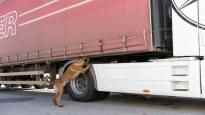A compromise could be that money for surveillance equipment would come from the EU, which would free up money for the member states to spend on physical fences.
On the night before Friday, the EU summit sent a message to the Commission that significant amounts of EU funds should be directed to strengthening external borders, i.e. strengthening border structures and surveillance equipment.
The debate on strengthening the EU’s external borders has been held from time to time, particularly lively especially since 2021, when Belarus was considered to have arranged the entry of illegal immigrants to Poland and the Baltic countries.
Within the EU countries, there are different views on how the external borders should be strengthened.
– According to meeting sources, the discussion was primarily about the development of EU border control. Some countries would like to use EU money to strengthen border security, especially to build fences. At the moment, for example, Bulgaria has a 237-kilometer-long fence on the border with Turkey, and some countries would like to strengthen this, explains EU expert, docent at the University of Helsinki Timo Miettinen.
Enhanced surveillance means, for example, air surveillance and guard booths in addition to the actual physical barriers.
The official staff of the summit estimated that if the monitoring equipment were financed from common funds, the member countries could pay for the border barriers from their own national budgets. The issue is written about by, among others, Politico magazine (you will switch to another service).
Chairman of the Commission Ursula von der Leyen has ruled that fences will not be paid for from common funds. Finland has followed the same lines.
The discussion continues, estimates Timo Miettinen.
– There are still differences in what kind of measures EU funds are ready to finance. Many countries would like to use EU funds to build fences. Some countries, such as Finland, have acted voluntarily and decided to build a fence from national budgets.
The Belarusian operation caught Finland by surprise
The situation of people being directed to Poland and the Baltic countries via Belarus prompted several countries to consider strengthening border security. The war in Ukraine has increased development needs.
– The change has been particularly visible in Finland, where the construction of a fence came into discussion after the war of aggression against Russia. The requirements for building fences have also increased in the Baltic countries. Building fences has become an acceptable theme in a certain way, analyzes Timo Miettinen.
They want to strengthen the border against Turkey
Different countries have confirmation needs just because of the geographical position.
According to Timo Miettinen, Denmark and Austria in particular have demanded that obstacles be financed from common funds to a greater extent than at present. Austria wants to limit the entry of people from the Balkans through Hungary to Austria illegally.
Austria also wants to strengthen the border between Bulgaria and Turkey with no less than two billion euros. According to the commission, there are only three billion left for projects related to fences, so strengthening a single border would swallow too much of the joint cake.
One group of countries got behind the strengthening of border control. Among others, Hungary, Denmark, the Baltic countries and Greece signed a letter demanding stricter border regulations on the eve of the summit on Wednesday.
The birth of the European bastion has older roots
In Europe, the border fence between the United States and Mexico, which was one president, has often been considered as a model Donald Trump’s election promises. The construction of the barrier has proven to be laborious due to, among other things, floods and difficult terrain. About 1,000 kilometers of fence are ready, about a third of the entire length of the border.
According to docent Timo Miettinen, the talk about fortress Europe has its roots in more distant history.
– It is above all related to looking at immigration as a security issue. The idea of Europe as a fortress has been confirmed, among other things, by the so-called refugee crisis of 2015, which showed that the EU is still lost when it comes to a common asylum policy. Reforms, especially regarding permanent quotas, have been difficult to achieve.
The bastion does not remove the causes of migration
Timo Miettinen urges to consider the root causes of migration in the problem of building barriers. Again and again, families are crammed into unseaworthy ships on a life-threatening journey across the Mediterranean, for example. In this case, a border fence is not a solution.
– It is clear that the obstacles are not related in any way to the root causes of immigration, regional instability and economic uncertainty. They will probably increase the popularity of sea routes and thus also the risk of an increase in deaths. EU countries should now rethink their strategy in Africa and the Middle East.
